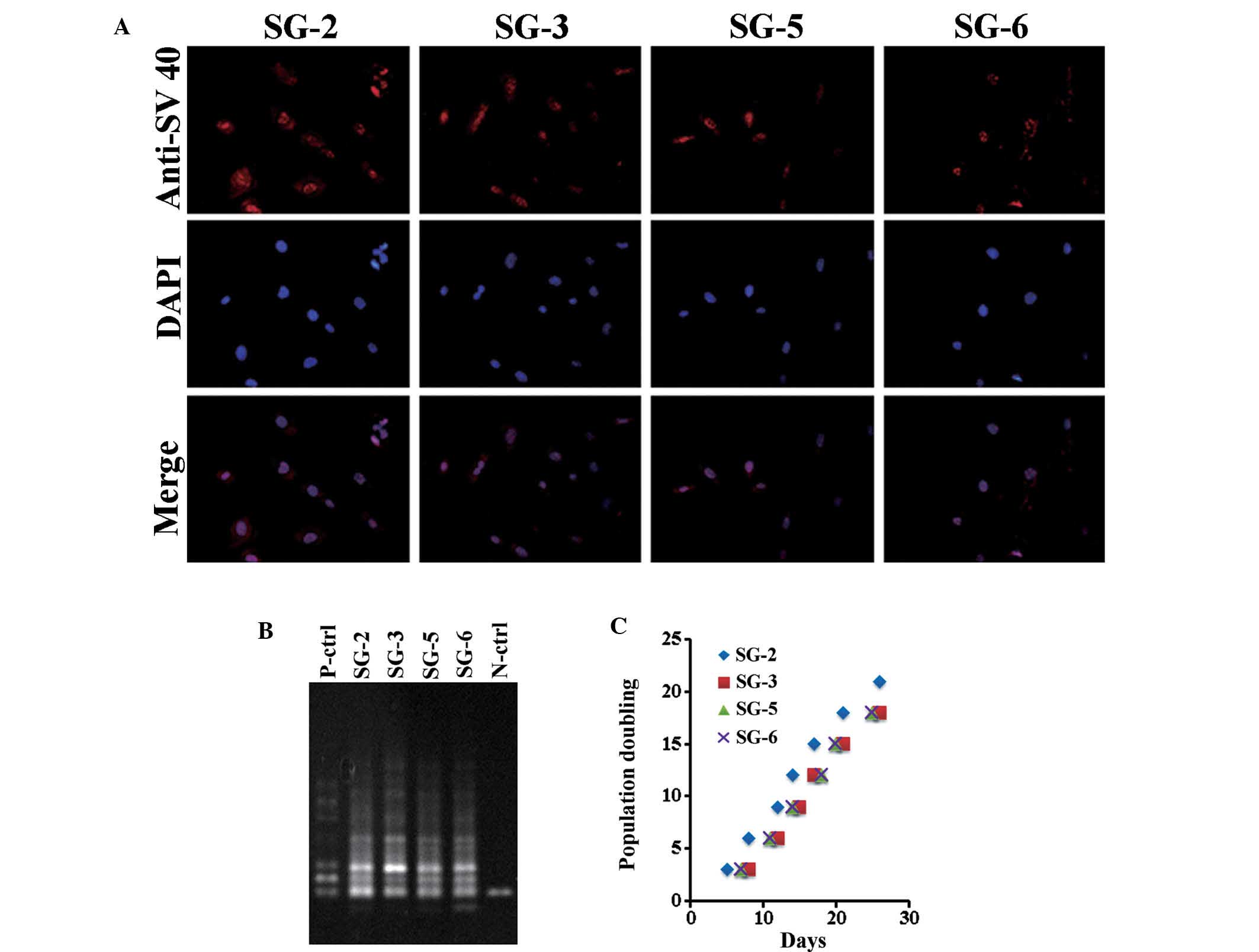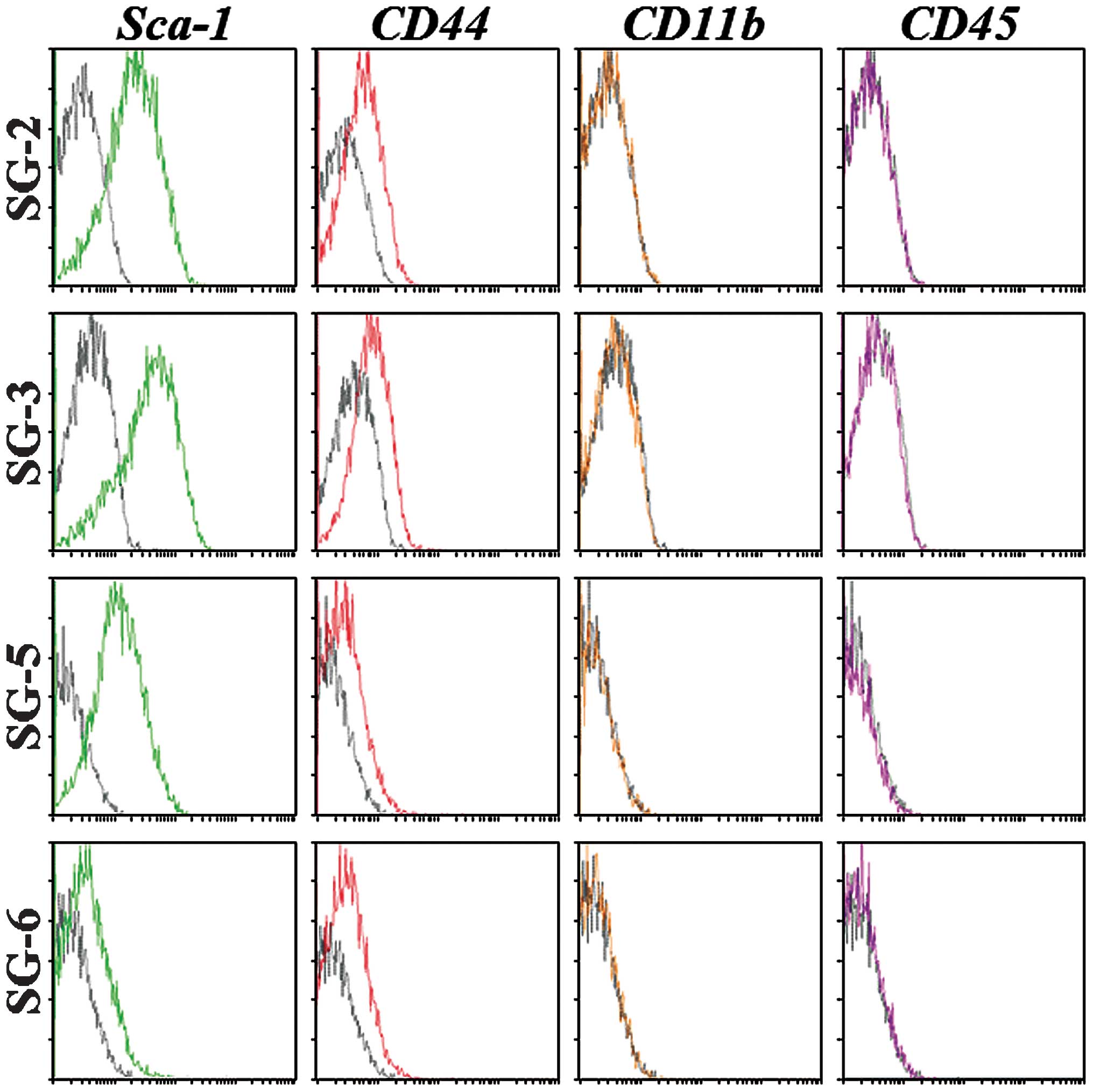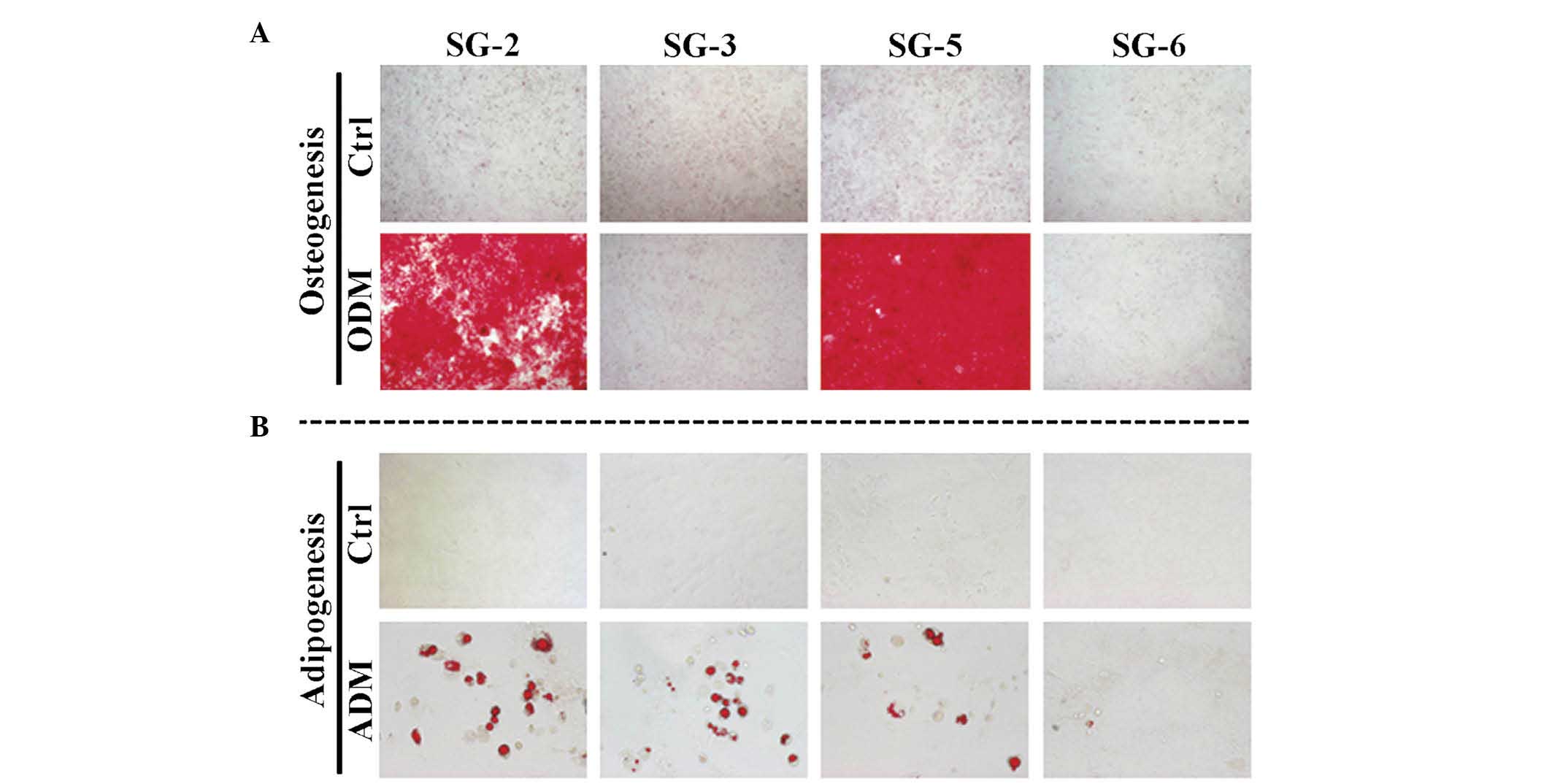|
1
|
Prockop DJ: Marrow stromal cells as stem
cells for nonhematopoietic tissues. Science. 276:71–74. 1997.
View Article : Google Scholar : PubMed/NCBI
|
|
2
|
Pittenger MF, Mackay AM, Beck SC, Jaiswal
RK, Douglas R, Mosca JD, Moorman MA, Simonetti DW, Craig S and
Marshak DR: Multilineage potential of adult human mesenchymal stem
cells. Science. 284:143–147. 1999. View Article : Google Scholar : PubMed/NCBI
|
|
3
|
Docheva D, Popov C, Mutschler W and
Schieker M: Human mesenchymal stem cells in contact with their
environment: Surface characteristics and the integrin system. J
Cell Mol Med. 11:21–38. 2007. View Article : Google Scholar : PubMed/NCBI
|
|
4
|
Baksh D, Song L and Tuan RS: Adult
mesenchymal stem cells: Characterization, differentiation and
application in cell and gene therapy. J Cell Mol Med. 8:301–316.
2004. View Article : Google Scholar : PubMed/NCBI
|
|
5
|
Kassem M, Abdallah BM and Saeed H:
Osteoblastic cells: Differentiation and transdifferentiation. Arch
Biochem Biophys. 473:183–187. 2008. View Article : Google Scholar : PubMed/NCBI
|
|
6
|
Jones E and Yang X: Mesenchymal stem cells
and bone regeneration: Current status. Injury. 42:562–568. 2011.
View Article : Google Scholar : PubMed/NCBI
|
|
7
|
Proff P and Römer P: The molecular
mechanism behind bone remodelling: A review. Clin Oral Investig.
13:355–362. 2009. View Article : Google Scholar : PubMed/NCBI
|
|
8
|
Lazar-Karsten P, Dorn I, Meyer G, Lindner
U, Driller B and Schlenke P: The influence of extracellular matrix
proteins and mesenchymal stem cells on erythropoietic cell
maturation. Vox Sang. 101:65–76. 2011. View Article : Google Scholar
|
|
9
|
Yew TL, Chang MC, Hsu YT, Weng WH, Tsai
CC, Chiu FY, Hung SC and He FY: Efficient expansion of mesenchymal
stem cells from mouse bone marrow under hypoxic conditions. J
Tissue Eng Regen Med. 7:984–993. 2013. View Article : Google Scholar
|
|
10
|
Weiss A and Attisano L: The TGF beta
superfamily signaling pathway. Wiley Interdiscip Rev Dev Biol.
2:47–63. 2013. View
Article : Google Scholar : PubMed/NCBI
|
|
11
|
Miyazawa K, Shinozaki M, Hara T, Furuya T
and Miyazono K: Two major Smad pathways in TGF-beta superfamily
signalling. Genes Cells. 7:1191–1204. 2002. View Article : Google Scholar : PubMed/NCBI
|
|
12
|
Heldin CH, Landström M and Moustakas A:
Mechanism of TGF-beta signaling to growth arrest, apoptosis and
epithelial-mesenchymal transition. Curr Opin Cell Biol. 21:166–176.
2009. View Article : Google Scholar : PubMed/NCBI
|
|
13
|
Meulmeester E and Ten Dijke P: The dynamic
roles of TGF-β in cancer. J Pathol. 223:205–218. 2011. View Article : Google Scholar
|
|
14
|
Imamura T, Oshima Y and Hikita A:
Regulation of TGF-β family signaling by ubiquitination and de
ubiquitination. J Biochem. 154:481–489. 2013. View Article : Google Scholar : PubMed/NCBI
|
|
15
|
Herhaus L and Sapkota GP: The emerging
roles of deubiquitylating enzymes (DUBs) in the TGFβ and BMP
pathways. Cell Signal. 26:2186–2192. 2014. View Article : Google Scholar : PubMed/NCBI
|
|
16
|
Lee SY, Lee JH, Kim JY, Bae YC, Suh KT and
Jung JS: BMP2 increases adipogenic differentiation in the presence
of dexamethasone, which is inhibited by the treatment of TNF-α in
human adipose tissue-derived stromal cells. Cell Physiol Biochem.
34:1339–1350. 2014. View Article : Google Scholar
|
|
17
|
Pountos I, Georgouli T, Henshaw K, Bird H,
Jones E and Giannoudis PV: The effect of bone morphogenetic
protein-2, bone morphogenetic protein-7, parathyroid hormone and
platelet-derived growth factor on the proliferation and osteogenic
differentiation of mesenchymal stem cells derived from osteoporotic
bone. J Orthop Trauma. 24:552–556. 2010. View Article : Google Scholar : PubMed/NCBI
|
|
18
|
Yokota J, Chosa N, Sawada S, Okubo N,
Takahashi N, Hasegawa T, Kondo H and Ishisaki A: PDGF-induced
PI3K-mediated signal enhances TGF-β-induced osteogenic
differentiation of human mesenchymal stem cells in the
TGF-β-activated MEK-dependent manner. Int J Mol Med. 33:534–542.
2014.PubMed/NCBI
|
|
19
|
Ray P and Chapman SC: Cytoskeletal
reorganaization drives mesenchymal condensation and regulates
downstream molecular signaling. PLoS One. 10:e01347022015.
View Article : Google Scholar
|
|
20
|
Sengle G, Carlberg V, Tufa SF, Charbonneau
NL, Smaldone S, Carlson EJ, Ramirez F, Keene DR and Sakai LY:
Abnormal activation of BMP signaling causes myopathy in Fbn2 null
mice. PLoS Genet. 11:e10053402015. View Article : Google Scholar : PubMed/NCBI
|
|
21
|
Kramman R and Humphreys BD: Kidney
pericytes: Roles in regeneration and fibrosis. Semin Nephrol.
34:374–383. 2014. View Article : Google Scholar
|
|
22
|
Touboul C, Vidal F, Pasquier J, Lis R and
Rafii A: Role of mesenchymal cells in the natural history of
ovarian cancer: A review. J Transl Med. 12:2712014. View Article : Google Scholar : PubMed/NCBI
|
|
23
|
Wise AF and Ricardo SD: Mesenchymal stem
cells in kidney inflammation and repair. Nephrology (Carlton).
17:1–10. 2012. View Article : Google Scholar
|
|
24
|
Okabe M, Ikawa M, Kominami K, Nakanishi T
and Nishimune Y: 'Green mice' as a source of ubiquitous green
cells. FEBS Lett. 407:313–319. 1997. View Article : Google Scholar : PubMed/NCBI
|
|
25
|
Aomatsu E, Takahashi N, Sawada S, Okubo N,
Hasegawa T, Taira M, Miura H, Ishisaki A and Chosa N: Novel
SCRG1/BST1 axis regulates self-renewal, migration and osteogenic
differentiation potential in mesenchymal stem cells. Sci Rep.
4:36522014. View Article : Google Scholar
|
|
26
|
Livak KJ and Schmittgen TD: Analysis of
relative gene expression data using real-time quantitative PCR and
the 2(−Delta Delta C(T)) Method. Methods. 25:402–408. 2001.
View Article : Google Scholar
|
|
27
|
Gee CJ and Harris H: Tumorigenicity of
cells transformed by Simian virus 40 and of hybrids between such
cells and normal diploid cells. J Cell Sci. 36:223–240.
1979.PubMed/NCBI
|
|
28
|
Howell N: Suppression of transformation
and tumorigenicity in interspecies hybrids of human
SV40-transformed and mouse 3T3 cell lines. Cytogenet Cell Genet.
34:215–229. 1982. View Article : Google Scholar : PubMed/NCBI
|
|
29
|
Kahn P, Topp WC and Shin S: Tumorigenicity
of SV40-transformed human and monkey cells in immunodeficient mice.
Virology. 126:348–360. 1983. View Article : Google Scholar : PubMed/NCBI
|
|
30
|
Nitta M, Katabuchi H, Ohtake H, Tashiro H,
Yamaizumi M and Okamura H: Characterization and tumorigenicity of
human ovarian surface epithelial cells immortalized by SV40 large T
antigen. Gynecol Oncol. 81:10–17. 2001. View Article : Google Scholar : PubMed/NCBI
|
|
31
|
Kang MK and Park NH: Extension of cell
life span using exogenous telomerase. Methods Mol Biol.
371:151–165. 2007. View Article : Google Scholar : PubMed/NCBI
|
|
32
|
Lee MK, Hande MP and Sabapathy K: Ectopic
mTERT expression in mouse embryonic stem cells does not affect
differentiation but confers resistance to differentiation- and
stress-induced p53-dependent apoptosis. J Cell Sci. 118:819–829.
2005. View Article : Google Scholar : PubMed/NCBI
|
|
33
|
Abraham S, Sweet T, Khalili K, Sawaya BE
and Amini S: Evidence for activation of the TGF-beta1 promoter by
C/EBP beta and its modulation by Smads. J Interferon Cytokine Res.
29:1–7. 2009. View Article : Google Scholar
|
|
34
|
Ramji DP and Foka P:
CCAAT/enhancer-binding proteins: Structure, function and
regulation. Biochem J. 365:561–575. 2002. View Article : Google Scholar : PubMed/NCBI
|
|
35
|
Zahnow CA: CCAAT/enhancer-binding protein
beta: Its role in breast cancer and associations with receptor
tyrosine kinases. Expert Rev Mol Med. 11:e122009. View Article : Google Scholar : PubMed/NCBI
|
|
36
|
Lekstrom-Himes J and Xanthopoulos KG:
Biological role of the CCAAT/enhancer-binding protein family of
transcription factors. J Biol Chem. 273:28545–28548. 1998.
View Article : Google Scholar : PubMed/NCBI
|
|
37
|
Akira S, Isshiki H, Sugita T, Tanabe O,
Kinoshita S, Nishio Y, Nakajima T, Hirano T and Kishimoto T: A
nuclear factor for IL-6 expression (NF-IL6) is a member of a C/EBP
family. EMBO J. 9:1897–1906. 1990.PubMed/NCBI
|
|
38
|
Williams SC, Cantwell CA and Johnson PF: A
family of C/EBP-related proteins capable of forming covalently
linked leucine zipper dimers in vitro. Genes Dev. 5:1553–1567.
1991. View Article : Google Scholar : PubMed/NCBI
|
|
39
|
Katz S, Kowenz-Leutz E, Müller C, Meese K,
Ness SA and Leutz A: The NF-M transcription factor is related to
C/EBP beta and plays a role in signal transduction, differentiation
and leukemogenesis of avian myelomonocytic cells. EMBO J.
12:1321–1332. 1993.PubMed/NCBI
|
|
40
|
Haas SC, Huber R, Gutsch R, Kandemir JD,
Cappello C, Krauter J, Duyster J, Ganser A and Brand K: ITD- and
FL-induced FLT3 signal transduction leads to increased C/EBP
beta-LIP expression and LIP/LAP ratio by different signalling
modules. Br J Haematol. 148:777–790. 2010. View Article : Google Scholar
|
|
41
|
Gutsch R, Kandemir JD, Pietsch D, Cappello
C, Meyer J, Simanowski K, Huber R and Brand K:
CCAAT/enhancer-binding protein beta inhibits proliferation in
monocytic cells by affecting the retinoblastoma protein/E2F/cyclin
E pathway but is not directly required for macrophage morphology. J
Biol Chem. 286:22716–22729. 2011. View Article : Google Scholar : PubMed/NCBI
|
|
42
|
Nerlov C: The C/EBP family of
transcription factors: A paradigm for interaction between gene
expression and proliferation control. Trends Cell Biol. 17:318–324.
2007. View Article : Google Scholar : PubMed/NCBI
|
|
43
|
Tsukada J, Yoshida Y, Kominato Y and Auron
PE: The CCAAT/enhancer (C/EBP) family of basic-leucine zipper
(bZIP) transcription factors is a multifaceted highly-regulated
system for gene regulation. Cytokine. 54:6–19. 2011. View Article : Google Scholar : PubMed/NCBI
|
|
44
|
Pham TH, Langmann S, Schwarzfischer L, El
Chartouni C, Lichtinger M, Klug M, Krause SW and Rehli M: CCAAT
enhancer-binding protein beta regulates constitutive gene
expression during late stages of monocyte to macrophage
differentiation. J Biol Chem. 282:21924–21933. 2007. View Article : Google Scholar : PubMed/NCBI
|
|
45
|
Liu S, Croniger C, Arizmendi C,
Harada-Shiba M, Ren J, Poli V, Hanson RW and Friedman JE:
Hypoglycemia and impaired hepatic glucose production in mice with a
deletion of the C/EBP beta gene. J Clin Invest. 103:207–213. 1999.
View Article : Google Scholar : PubMed/NCBI
|
|
46
|
Croniger CM, Millward C, Yang J, Kawai Y,
Arinze IJ, Liu S, Harada-Shiba M, Chakravarty K, Friedman JE, Poli
V and Hanson RW: Mice with a deletion in the gene for
CCAAT/enhancer-binding protein beta have an attenuated response to
cAMP and impaired carbohydrate metabolism. J Biol Chem.
276:629–638. 2001. View Article : Google Scholar
|
|
47
|
Poli V: The role of C/EBP isoforms in the
control of inflammatory and native immunity functions. J Biol Chem.
273:29279–29282. 1998. View Article : Google Scholar : PubMed/NCBI
|
|
48
|
Zwergal A, Quirling M, Saugel B, Huth KC,
Sydlik C, Poli V, Neumeier D, Ziegler-Heitbrock HW and Brand K:
C/EBP beta blocks p65 phosphorylation and thereby NF-kappa
B-mediated transcription in TNF-tolerant cells. J Immunol.
177:665–672. 2006. View Article : Google Scholar : PubMed/NCBI
|
|
49
|
Cappello C, Zwergal A, Kanclerski S, Haas
SC, Kandemir JD, Huber R, Page S and Brand K: C/EBP beta enhances
NF-kappaB-associated signalling by reducing the level of
IkappaB-alpha. Cell Signal. 21:1918–1924. 2009. View Article : Google Scholar : PubMed/NCBI
|
|
50
|
Liu Y, Nonne macher MR and Wigdahl B:
CCAAT/enhancer-binding proteins and the pathogenesis of retrovirus
infection. Future Microbiol. 4:299–321. 2009. View Article : Google Scholar : PubMed/NCBI
|
|
51
|
Spooner CJ, Guo X, Johnson PF and Schwartz
RC: Differential roles of C/EBP beta regulatory domains in
specifying MCP-1 and IL-6 transcription. Mol Immunol. 44:1384–1392.
2007. View Article : Google Scholar
|
|
52
|
Abraham M, Shapiro S, Karni A, Weiner HL
and Miller A: Gelatinases (MMP-2 and MMP-9) are preferentially
expressed by Th1 vs. Th2 cells. J Neuroimmunol. 163:157–164. 2005.
View Article : Google Scholar : PubMed/NCBI
|
|
53
|
Guo J, Zhang H, Xiao J, Wu J, Ye Y, Li Z,
Zou Y and Li X: Monocyte chemotactic protein-1 promotes the
myocardial homing of mesenchymal stem cells in dilated
cardiomyopathy. Int J Mol Sci. 14:8164–8178. 2013. View Article : Google Scholar : PubMed/NCBI
|
|
54
|
Belema-Bedada F, Uchida S, Martire A,
Kostin S and Braun T: Efficient homing of multipotent adult
mesenchymal stem cells depends on FROUNT-mediated clustering of
CCR2. Cell Stem Cell. 2:566–575. 2008. View Article : Google Scholar : PubMed/NCBI
|
|
55
|
Gerard C and Rollins BJ: Chemokines and
disease. Nat Immunol. 2:108–115. 2001. View
Article : Google Scholar : PubMed/NCBI
|
|
56
|
Rot A and von Andrian UH: Chemokines in
innate and adaptive host defense: Basic chemokinese grammar for
immune cells. Annu Rev Immunol. 22:891–928. 2004. View Article : Google Scholar : PubMed/NCBI
|
|
57
|
Dwyer RM, Potter-Beirne SM, Harrington KA,
Lowery AJ, Hennessy E, Murphy JM, Barry FP, O'Brien T and Kerin MJ:
Monocyte chemotactic protein-1 secreted by primary breast tumors
stimulates migration of mesenchymal stem cells. Clin Cancer Res.
13:5020–5027. 2007. View Article : Google Scholar : PubMed/NCBI
|
|
58
|
Schenk S, Mal N, Finan A, Zhang M,
Kiedrowski M, Popovic Z, McCarthy PM and Penn MS: Monocyte
chemotactic protein-3 is a myocardial mesenchymal stem cell homing
factor. Stem Cells. 25:245–251. 2007. View Article : Google Scholar
|
|
59
|
Zhou YL, Zhang HF, Li XL, Di RM, Yao WM,
Li DF, Feng JL, Huang J, Cao KJ and Fu M: Increased
stromal-cell-derived factor 1 enhances the homing of bone marrow
derived mesenchymal stem cells in dilated cardiomyopathy in rats.
Chin Med J (Engl). 123:3282–3287. 2010.
|
|
60
|
Zhuang Y, Chen X, Xu M, Zhang LY and Xiang
F: Chemokine stromal cell-derived factor 1/CXCL12 increases homing
of mesenchymal stem cells to injured myocardium and
neovascularization following myocardial infarction. Chin Med J
(Engl). 122:183–187. 2009.
|
|
61
|
Abbott JD, Huang Y, Liu D, Hickey R,
Krause DS and Giordano FJ: Stromal cell-derived factor-1 alpha
plays a critical role in stem cell recruitment to the heart after
myocardial infarction but is not sufficient to induce homing in the
absence of injury. Circulation. 110:3300–3305. 2004. View Article : Google Scholar : PubMed/NCBI
|
|
62
|
Mozid AM, Arnous S, Sammut EC and Mathur
A: Stem cell therapy for heart diseases. Br Med Bull. 98:143–159.
2011. View Article : Google Scholar : PubMed/NCBI
|

















